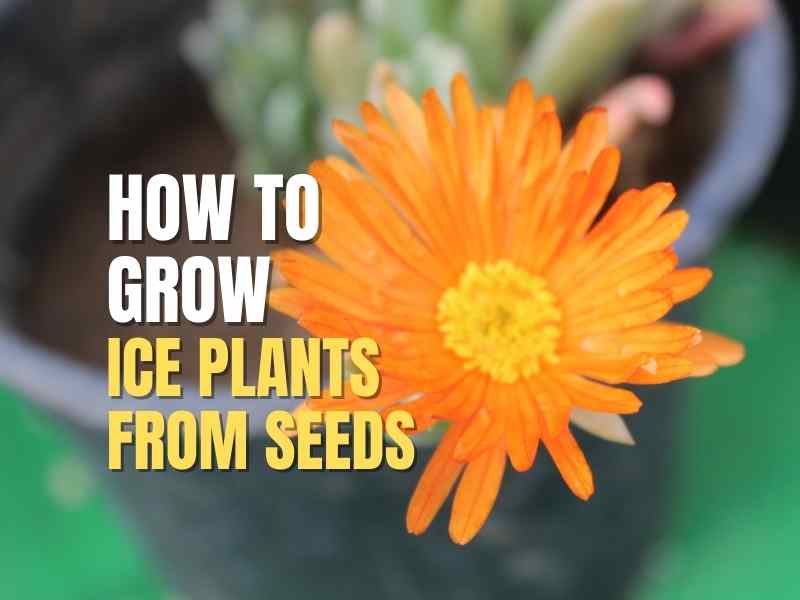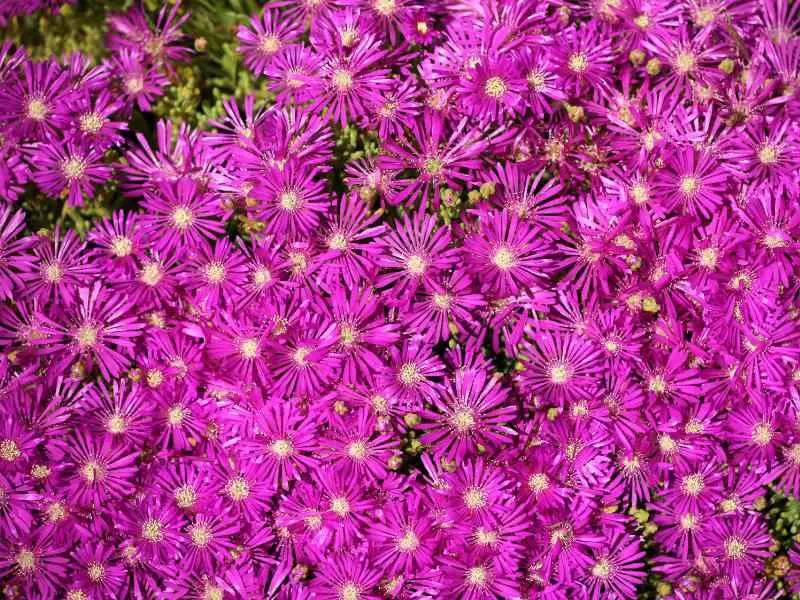Ice Plants produce lovely colorful flowers that will surely add a bright and eye-catching sight to your home garden. You can rely on this plant even if your growing area is a bit dry. They are drought-tolerant plants and you don’t have to take much care of them while growing.

There are many different genera of ice plants known nowadays. They were once part of a single genus known as Mesembryanthemum. But that grouping is now invalid and they are now classified into several different genera. They are commonly known as ice plants.
Growing the ice plants in your home garden will give you plenty of succulent, perennial flowers. In this article, we are going to learn how to grow ice plants from seeds. Stay tuned and keep reading to learn the basics and all the requirements for growing this plant in detail.
ICE PLANTS INFORMATION
This succulent belongs to the family of Aizoaceae and it is a perennial, herbaceous plant. This plant is native to Africa and grows best in USDA hardiness zones 6 to 10.
Different ice plant varieties grow in different sizes but the average size is 3 to 6 inches in length and one to two feet in width. The flower could be yellow, red, purple, pink, or orange. There could also be bi or tri-color varieties of ice plants.
ICE PLANTS VARIETIES TO GROW
As told before, once the ice plants were classified into one genus, but now they are divided into multiple genera. The commonly known ice plant varieties have botanical names Delosperma, Lampranthus, Drosanthemum, cephalophyllum, and Carpobrotus.
How many varieties of Ice Plants are there?
Below are some of the varieties of ice plants that are more popular among gardeners.
DELOSPERMA COOPERI
This ice plant variety is commonly known as Cooper’s ice plant. It produces purple or magenta flowers and it is one of the most common plant varieties. The plant grows best in USDA hardiness zones 6, 7, 8, 9, and 10.
DELOSPERMA HERBEAU
One of the most beautiful flowers produces a variety of ice plants. This is commonly known as the Hardy white ice plant because of the white flowers it produces.
DELOSPERMA FLORIBUNDUM
Want pink-colored flowers for your home garden or need them as your indoor plants, this ice plant could be your pick. It produces lovely pink flowers that also have a white center and it is commonly known as a starburst. This plant grows best in USDA hardiness zones 6, 7, and 8.
DELOSPERMA BRUNNTHALERI
Hardy yellow is the other name of the delosperma brunnthaleri ice plant. As the name indicates, this variety produces yellow flowers. You can count it as the dwarf variety of ice plants because it grows up to only 2 inches tall. But the width could be up to 2 feet. This lovely yellow flower ice plant grows best in USDA hardiness zones 4, 5, 6, 7, 8, and 9.
LAMPRANTHUS AURANTIACUS
The bright and catchy orange flowers are this plant’s production. This one is different from other ice plants because this is a quite long plant that grows up to a foot to a foot and a half in length. That’s pretty high for ice plants. It can be best grown in 9,10 and 11 USDA hardiness zones.
DELOSPERMA ‘ALAN’S APRICOT’
This is one of the cold-hardy plants you can grow. Also the award winner variety of ice plants. The best part is that it is very cold hardy and has a really long blossom period. It produces pink flowers that could possibly fade and turn to apricot color.
DELOSPERMA LAVENDER ICE
This was also an award-winning variety of ice plants back in 2009. The lavender-pink flowers are produced by this plant through a long blossom season. It has evergreen foliage that changes its color in winter.
DELOSPERMA DYERI RED MOUNTAIN FLAME
This plant has been one of the best heat-tolerant ice plant varieties. But don’t worry if you have a dry and hot climate, this plant would not cause you much problem. It produces scarlet orange flowers.
DELOSPERMA FIRE SPINNER
Do you want a bunch of bi-color flowers blooming this spring in your garden? This plant is for you as it will produce orange and purple flowers. One thing to keep in mind is that this plant needs chilling weather to produce the best results. If your growing area has warm winters, it is not recommended to go for this ice plant.
DELOSPERMA SP. LESOTHO PINK
This is another pink flower producing a variety of ice plants. It is best grown in high-altitude areas where summers are cooler. Keep in mind that they are not suitable for areas with hot weather.
DELOSPERMA ASHTONII BLUT
This evergreen succulent has a very long bloom season. It is one of the longest-living ice plants that produce magenta flowers. The foliage turns to plum color during the winter season.
HOW TO GROW ICE PLANTS FROM SEEDS

Ice plants are drought-tolerant succulents and they can perform well in poor soil. Another thing that you have to keep in mind is that these plants are invasive. So plant them by considering this.
Ice plants can be grown by multiple methods like growing from cuttings or using the division method. But in this article, we are going to see how we can grow this plant from seeds.
Follow the steps given below to get the best results.
- First thing first, you need to get some good quality seeds from your trusted plant store. An average or low-quality seed would possibly not germinate at all.
- To germinate these seeds, use seed starting trays or small-sized plastic pots. It’s better to start the plant in a container so that you don’t have to disturb the plant. This is needed only when you want to grow the ice plant in containers.
- If you want to plant them in the garden soil then starter trays or small pots will suit them best.
- Fill the pot or tray with good-quality potting soil. Make sure the soil also has good drainage. This is important for the germination stage but once the plant is established, it doesn’t get affected by poor soil.
- It is recommended to pre-water the soil to let it adjust properly and not remain too dry when you are starting the new pant.
- You have to leave a quarter-inch space between the soil and the top of your container or pot.
- Now add some gravel on top of your soil.
- When are you planting your ice plant? This is the important question and the answer should be that you have to sow the seeds 4 to 6 weeks before the last expected frost so that you can transplant them outside at the best time.
- Now add some seeds to the gravel and let the seeds reach the soil by tamping slowly.
- There are two most important things that you need to keep in mind while sowing the ice plant seeds.
- First of all the seeds must not get covered by soil or gravel. They should only touch the soil.
- The second important thing is that sunlight must also reach properly to the seeds. This means your chosen location must get enough sunlight. If you fail in this step, don’t hope for the seeds to germinate.
- Indoor planting of ice plants is also dependent on light. Choose the spot that gives plenty of sunlight. Also, the temperature must remain above 60 degrees Fahrenheit.
- There is also another way of sowing the seeds in the soil. The technique is called tilling. It is easy to use when you are growing in containers.
- In this method, you can use a small stick and start gently pricking your container soil with it. You are hard on it as excessive tilling is harmful to the soil.
- Now sprinkle the seeds on the soil.
- These seeds must not be buried in the soil and should remain over the soil surface.
- You can add a very thin layer of sand if you desire.
- Now it’s time to spray water on your ice plant seeds to keep the moisture level required by your seeds to germinate.
- Soggy soil or too much watering would surely cause problems for you.
- The watering routine should continue like this till your see new plants sprouting out. Just keep them moist only.
- At this stage, you must be having a bunch of very young little seedlings of ice plants.
- Now if you plan to move them outside in your main garden space or outdoor garden, you need to harden them off.
- On the first day only keep the small plants in direct sunlight and under outdoor weather conditions for one hour only.
- Next day you can add half an hour more to the previous day’s time.
- Similarly, keep on increasing this exposure time. Keep this practice for about 2 weeks. This process is known as hardening off.
- After you are done hardening them off, you are good to go to transplant them outdoors.
- One last thing before planting them outside is to make sure that the frost danger has passed.
- By keeping one and a half feet of distance between each new plant, you can transplant them in full sunlight.
- Once the plant is established, no more care is needed. Not even regular watering routines. They are drought tolerant.
- You also don’t have to worry about adding any kind of fertilizer to your soil, they can give good results in poor soil also.
- Now sit back and watch the beautiful eye-catching flowers growing in your garden space.
READ THIS
HOW TO GROW RED YUCCA FROM SEED
HOW TO GROW BUSH CUCUMBERS IN CONTAINERS
References
https://homeguides.sfgate.com/sow-ice-plant-seeds-69735.html
https://www.houzz.com/discussions/1576078/starting-ice-plant-from-seed

